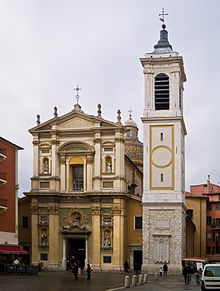Nice Cathedral
| Cathedral of Saint Reparata Cathédrale Sainte-Réparate |
|
|---|---|

Nice Cathedral
|
|
| Basic information | |
| Location | Nice, France |
| Geographic coordinates | 43°41′50″N 7°16′33″E / 43.69722°N 7.27583°ECoordinates: 43°41′50″N 7°16′33″E / 43.69722°N 7.27583°E |
| Affiliation | Roman Catholic |
| District | Diocese of Nice |
| Ecclesiastical or organizational status | Cathedral |
| Architectural description | |
| Architectural type | Church |
| Architectural style | Baroque |
| Groundbreaking | 1650 |
| Completed | 1699 |
Nice Cathedral (French: Basilique-Cathédrale Sainte-Marie et Sainte-Réparate de Nice) is the cathedral of the Diocese of Nice and is located in the old town of Nice in the south of France. It was built between 1650 and 1699, the year of its consecration. It is dedicated to the Assumption of the Virgin Mary and Saint Reparata.
It has been classed as a monument historique since 9 August 1906.
On the site, the first cathedral was consecrated in 1049, St. Mary of the Castle.
In the year 1060, relics belonging to St. Reparate (For whom the current cathedral is named) arrived in the city of Nice.
By the year 1075 there was construction at the foot of the Castle of a chapel dedicated to St. Reparate.
During the later half of the twelfth century, the chapel became the priory of the abbey of Saint-Pons.
The year 1246 marked the official elevation of the priory to a parish.
The first church on the site was built in the early 13th century on land belonging to the Abbey of St. Pons and became a parish church in 1246.
1455 to 1468, Population growth led to additions being built onto the church.
During the first half of the 16th century a series of acts gradually effected the transfer of the seat of the bishops of Nice from Cimiez Cathedral on the hill of the castle overlooking the city to the church of Saint Reparata which in 1590, after an official ceremony presided over by the then bishop, Luigi Pallavicini, and in the presence of Charles Emmanuel I, Duke of Savoy, was recognised as a chiesa-cattedrale.
However, in 1649, judging the building too small, bishop Didier Palletis commissioned the architect Jean-André Guibert to produce a structure more in keeping with the importance of the city.
1650 to 1685, The construction of a new cathedral (The current main building) occurs during this time.
In 1699 the new cathedral is officially consecrated but the construction is an ongoing process.
From 1731 to 1759 the now widely recognized bell tower is built.
...
Wikipedia
